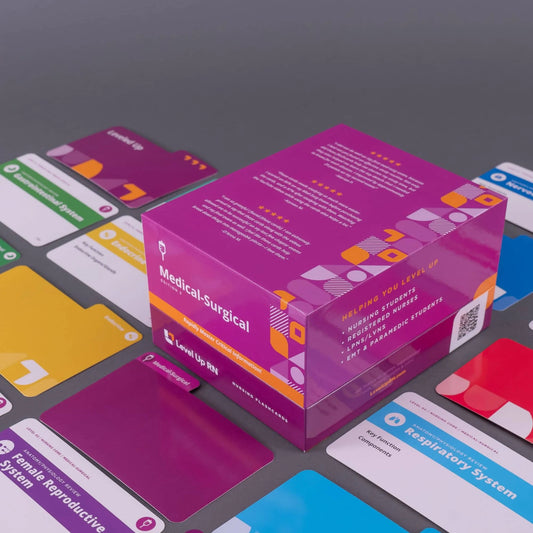Medical-Surgical Nursing - Flashcards
In this article, we'll cover basics on the dysrhythmias you need to know about in med-surg. We won't go into any details about EKG interpretation; if you need to learn EKG interpretation for these dysrhythmias, you can check out our EKG Interpretation - Nursing Flashcards.
The Med-Surg Nursing video series follows along with our Medical-Surgical Nursing Flashcards, which are intended to help RN and PN nursing students study for nursing school exams, including the ATI, HESI, and NCLEX.
Sinus dysrhythmias
Sinus dysrhythmias include sinus tachycardia, sinus bradycardia, and sinus arrhythmia.
Sinus Tachycardia
Sinus tachycardia is a regular cardiac rhythm wherein the heart rate is greater than 100 BPM.
Tachycardia causes
The causes of sinus tachycardia can include physical activity, anxiety, fever, pain, anemia, medications, or as compensation for decreased cardiac output or blood pressure.
Tachycardia treatment
The recommended treatment for sinus tachycardia is to treat the underlying cause. For example, for sinus tachycardia due to a fever, the goal would be to treat the fever!
Sinus Bradycardia
Sinus bradycardia is a regular cardiac rhythm wherein the heart rate is less than 60 BPM.
Bradycardia causes
Sinus bradycardia can be brought on by excess vagal nerve stimulation, cardiovascular disease, cardiovascular infection, hypoxia, or certain medications. Sinus bradycardia is a normal or expected finding in athletes (because their heart might be working very efficiently and does not need to beat as often).
Bradycardia treatment
The treatment for sinus bradycardia as an abnormal finding is atropine or a pacemaker (for symptomatic bradycardia).
Sinus Arrhythmia
Sinus arrhythmia is a normal variant from a normal sinus rhythm where the heart rate increases slightly with inspiration (breathing in) and decreases slightly with expiration (breathing out).
Sinus arrhythmia causes
Sinus arrhythmia is common in children and typically disappears with increased age.
Sinus arrhythmia treatment
Treatment for sinus arrhythmia is usually not necessary.
Atrial dysrhythmias
Atrial dysrhythmias include atrial fibrillation, atrial flutter, premature atrial complexes, and supraventricular tachycardia.
Atrial dysrhythmia risk factors
Risk factors for atrial dysrhythmias in general include heart disease, cardiac surgery, increased age, and diabetes.
Atrial Fibrillation (AFIB)
Atrial fibrillation (AFIB) is rapid and disorganized depolarization of the atria in the heart which causes the atria to quiver or “fibrillate” instead of fully squeezing. This causes blood to collect in the atria, which places a patient at HIGH risk for clots.
AFIB treatment
Treatment for atrial fibrillation includes cardioversion, antiarrhythmics, and/or anticoagulants.
Atrial Flutter
Atrial flutter is when an abnormal electrical circuit forms in the atria of the heart, causing it to depolarize 250 - 350 times per minute.
Atrial flutter treatment
The treatment for atrial flutter is cardioversion and/or antiarrhythmics.
Premature Atrial Complexes (PAC)
Premature atrial complexes (PACs) are premature discharges of the electrical signal in the atria of the heart.
PAC Treatment
Treatment of PACs is not usually necessary. What can help reduce PACs is decreasing stress, and avoiding alcohol and caffeine.
Supraventricular Tachycardia (SVT)
Abnormally fast HR that originates above (supra = above) the ventricles, typically in the atria.
SVT Treatment
The treatment for SVT is usually cardioversion and antiarrhythmics.
Ventricular Dysrhythmias
Ventricular dysrhythmias include premature ventricular complexes, ventricular tachycardia, ventricular fibrillation, and asystole.
Ventricular dysrhythmia risk factors
The risk factors for ventricular dysrhythmia risk factors include heart disease, a myocardial infarction (heart attack), and electrolyte imbalances.
Premature Ventricular Complexes (PVCs)
A premature ventricular complex (PVC) is an abnormal impulse that originates from the ventricle and occurs early.
PVCs treatment
The treatment for PVCs include antiarrhythmics, when the PVCs are symptomatic.
Ventricular Tachycardia (VT/V-tach)
Ventricular tachycardia is a rapid ventricular heart rhythm greater than 100 beats per min, usually due to ischemic heart disease. VT can often deteriorate into ventricular fibrillation (explained next).
VT treatment
The treatment for ventricular tachycardia when the patient has a pulse is cardioversion, antiarrhythmics, and correcting electrolyte imbalances.
The treatment for ventricular tachycardia when the patient does not have a pulse is defibrillation (Clear!).
Ventricular Fibrillation (VF/V-fib)
Ventricular fibrillation is rapid, ineffective quivering of the ventricles in the heart.
VF treatment
Ventricular fibrillation is an emergency so the treatment is defibrillation!
Asystole
Asystole is the absence of any ventricular rhythm. The EKG of asystole is basically a flat line, which is where the term "flatlining" comes from. Usually, asystole happens after V-tach or V-fib has deteriorated.
Asystole treatment
The treatment for a patient in asystole is immediate CPR. Asystole is a "non-shockable rhythm" so defibrillation would not be done.
Atrioventricular (AV Block)
Atrioventricular (AV) blocks are some dysrhythmias you should know about, and there are two types: first-degree AV block and second-degree AV block.
AV block risk factors
The risk factors for AV blocks include coronary heart disease, myocardial infarction, and medications like digoxin or beta blockers.
First-Degree AV Block
A first-degree AV block is a prolonged impulse conduction time from the atria to the ventricles in the heart due to a delay in the AV node. First-degree AV block usually does not require treatment, but may progress into a more severe block.
Second-Degree Type 1 AV Block
A second-degree type 1 AV block is marked by a progressive increase in impulse conduction time between the atria and ventricles until one impulse finally fails to conduct at all. Second-degree type 1 AV block is usually temporary and does not require treatment.
Second-Degree Type 2 AV Block
A second-degree type 2 AV block is marked by a sudden failure of impulse conduction from the atria to the ventricles, without a progressive increase in conduction time.
Second-degree type 2 AV block usually requires a pacemaker.
Third-Degree AV Block
Third-degree AV block is a complete failure of any and all impulse conduction from the atria to the ventricles. A third-degree AV block requires a pacemaker for the patient.



1 comment
Love it!
So simplified